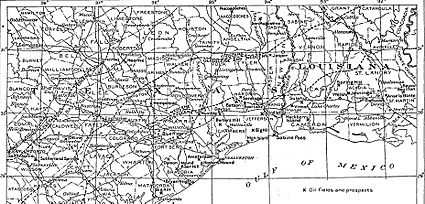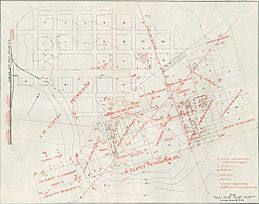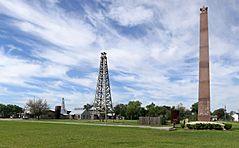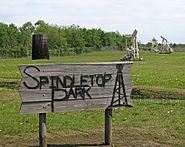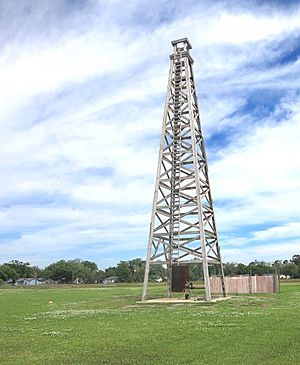Spindletop facts for kids
|
Spindle Top History
|
|
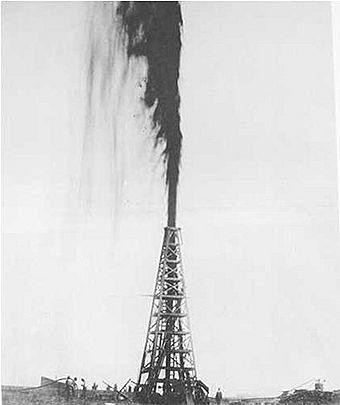
The Lucas gusher at Spindletop, January 10, 1901: This was the first major gusher of the Texas oil boom.
|
|
| Location | 3 mi south of Beaumont, Texas on Spindletop Ave. |
|---|---|
| Area | 1,130.4 acres (457.5 ha) |
| Built | 1901 |
| NRHP reference No. | 66000818 |
Quick facts for kids Significant dates |
|
| Added to NRHP | November 13, 1966 |
| Designated NHL | November 13, 1966 |
Spindletop is an important oil field located near Beaumont, Texas, in the United States. The oil here was found in a special dome-shaped rock formation. This formation was made from salt layers that formed millions of years ago.
On January 10, 1901, a well at Spindletop struck oil. This event is called "coming in." The Spindletop gusher shot oil high into the air for nine days! It produced an amazing 100,000 barrels of oil every day.
Companies like Gulf Oil and Texaco (now part of Chevron Corporation) were created to get this oil out of the ground. The discovery at Spindletop changed everything for the United States. It helped the country enter the "oil age." Before Spindletop, oil was mostly used for lamps and as a lubricant. But because so much oil was found, burning petroleum as a fuel became much cheaper.
This exciting time of oil exploration and growth in Texas became known as the Texas oil boom. Soon, the United States became the world's top oil producer.
Contents
The Story of Spindletop Oil
Patillo Higgins wanted to find natural gas for his brick factory. He believed there was oil and gas under a place called Sour Spring Mound. The oil field later got its name, Spindletop, from a nearby hill. This hill looked like a spindle because of the trees on its top. The mound was also known for natural gas leaks. Higgins would even light these gas leaks for his Sunday school class.
In 1892, Higgins and some partners formed the Gladys City Oil, Gas, and Manufacturing Company. They tried to drill for oil. But they had trouble getting past 300 feet (91 meters). They kept hitting a tricky, quicksand-like rock layer. Higgins left the company in 1896.
Drilling for Oil
Pattillo Higgins then teamed up with Captain Anthony F. Lucas. Lucas was an expert on salt-dome formations in the U.S. In 1899, Lucas made a deal with the Gladys City Company and Higgins. Lucas started drilling but ran out of money after reaching 575 feet (175 meters).
He got more money from John H. Galey, James M. Guffey, and Andrew Mellon. They formed the Guffey Petroleum Company. But Lucas only got a small share, and Higgins got nothing from this new deal.
Lucas and Galey hired the Hamill brothers to do the drilling. Galey chose the spot for the well near Sour Spring Mound. They started drilling on October 27, 1900. At 160 feet (49 meters), they hit the quicksand that had stopped others.
Overcoming Challenges
To get through the quicksand, they used a special eight-inch pipe. They pushed this pipe through the sand for 20 days. They also used a smaller pipe to flush out the sand with water. At about 250 feet (76 meters), Lucas invented a special valve. This valve stopped gas pressure from pushing sand back into the pipe. This helped them reach 445 feet (136 meters), past the thick quicksand.
At 645 feet (197 meters), they started working 18-hour shifts. They drilled during the day and kept water circulating at night. This was to prevent a gas blowout. In early December, they hit a layer of coarse water sand. They then tried something new: mixing mud into the water. This "drilling mud" made the hole stable. Soon, they were drilling into a clay layer called gumbo.
The Lucas Gusher
At 800 feet (244 meters), they reached limestone. On December 9, oil started to appear in the mud pit. This oil came from a 35-foot (11-meter) thick oil sand layer at 870 feet (265 meters). But this oil sand was too soft to use then. Lucas's wife, Caroline, convinced Galey to keep drilling to 1,200 feet (366 meters), as their contract said.
On Christmas Eve, they put a six-inch pipe below the sand at 880 feet (268 meters). They returned after the holidays. They hit another gas pocket, which pushed water and mud out of the hole. Then, at 960 feet (293 meters), they found a sulfur layer, followed by more limestone.
On January 10, 1901, they needed to change their drill bit. As they lowered the pipe back down, they heard a low rumble. Mud, then the drill pipe, shot out of the hole. There was a moment of silence, then an explosion of more mud and gas. More silence, then oil began to flow. Finally, a loud roar filled the air.
At a depth of 1,139 feet (347 meters), the Lucas Gusher, also called the Lucas Geyser, erupted! Oil shot over 150 feet (46 meters) into the air. It flowed at an incredible rate of 100,000 barrels per day. It took nine days to get the well under control. The Hamill brothers used a special device called a Christmas Tree to stop the flow.
The Oil Boom Begins
By late June, 1901, there were 13 gushers at Spindletop. Many companies, including the J.M. Guffey Company and Higgins Oil and Fuel Company, found oil. In July 1901, the Hogg-Swayne Syndicate leased more land.
Spindletop was the biggest oil gusher the world had ever seen. It turned Beaumont into a busy boomtown. Beaumont's population of 10,000 people tripled in just three months! It eventually grew to 50,000. Land prices shot up very quickly. By the end of 1902, over 500 oil companies had started, and 285 wells were pumping oil.
Spindletop produced over 17 million barrels of oil in 1902. But production dropped by half in 1903. Still, Spindletop inspired people to search for oil all along the Gulf Coastal Plain. Many other important oil fields were found, like Sour Lake and Saratoga in 1902, Batson Prairie in 1903, Humble in 1905, and Goose Creek in 1908.
New Oil Companies Emerge
Standard Oil, a very large oil company in the eastern U.S., could not easily enter this new oil field. Texas had laws against monopolies. People in Texas were also against Standard Oil's business practices. Even though Standard Oil built refineries in the area, it could not control the new Gulf Coast oil fields.
Because of this, many new oil companies started at Spindletop. Companies like Texaco and Gulf Oil grew into strong competitors against Standard Oil.
One of the drillers at Spindletop was W. Scott Heywood. In 1901, he made the first oil discovery in nearby Jeff Davis Parish in Louisiana.
Later Years of Spindletop
Oil production at Spindletop quickly went down after 1902. By 1904, the wells produced only 10,000 barrels per day. The developers had signed a 20-year contract to sell 25,000 barrels per day to Shell Oil at a low price. When oil prices went up, this deal caused problems. Andrew Mellon, who had lent money for Spindletop, took control of the company. He was able to cancel the contract. In 1907, he created Gulf Oil.
On November 14, 1925, the Yount-Lee Oil Company found more oil at a deeper level. This started a second oil boom at Spindletop. The field had its best production year in 1927, producing 21 million barrels. Spindletop continued to be a good source of oil until about 1936. Even today, some wells still produce small amounts of oil. From the 1950s to about 1975, the area was also mined for sulfur.
Spindletop-Gladys City Boomtown Museum
In 1976, Lamar University opened the Spindletop-Gladys City Boomtown Museum. This museum helps people learn about the history of the Spindletop oil gusher. The museum has a model oil derrick. It also has many reconstructed buildings from Gladys City. Inside, you can see real items from the Spindletop boomtown era.
The Lucas Gusher Monument is at the museum. This monument was first put up at the wellhead in 1941. But it became unstable because the ground sank. So, it was moved to the Spindletop-Gladys City Museum. The monument was originally very close to the actual Spindletop well site.
Today, the original wellhead is marked at Spindletop Park. A flagpole flying the Texas flag stands there. This park is about 1.5 miles south of the museum. It has a viewing platform with information signs. The actual wellhead site is in the middle of a swamp on private land, so you cannot reach it directly. You can get directions to the park and viewing platform at the museum.
On December 4, 1955, the story of Spindletop was shown on the CBS history TV series, You Are There. The episode was called "Spindletop – The First Great Texas Oil Strike."
See also
 In Spanish: Spindletop para niños
In Spanish: Spindletop para niños




